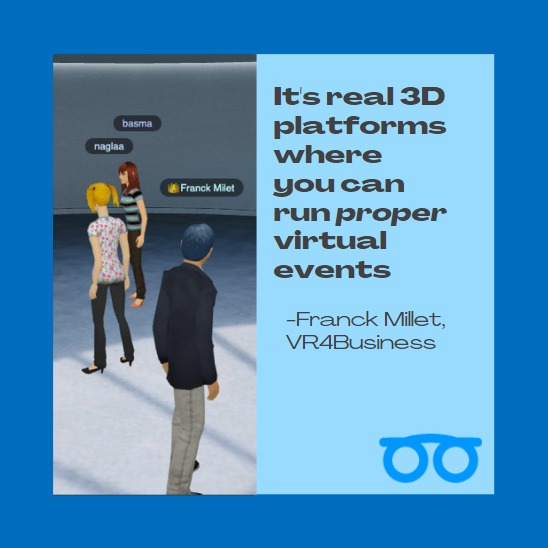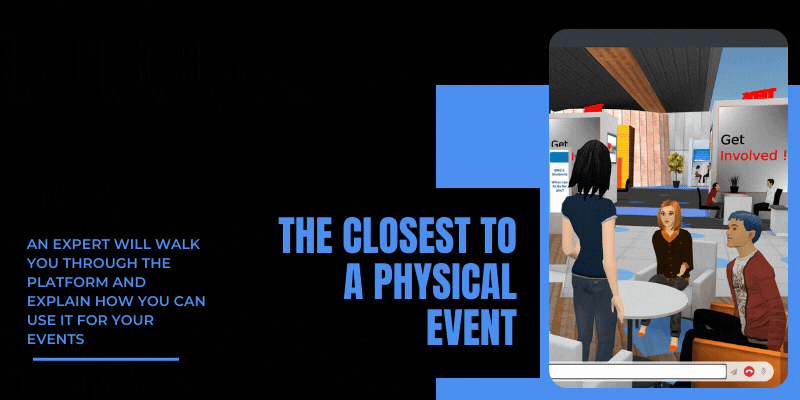Are you looking to host a virtual trade show or event? Virtual trade show software can help make your online events successful. From creating an interactive exhibit hall, hosting engaging presentations and workshops, and providing networking opportunities for attendees, the right virtual trade show platform will provide all these features and more. To ensure you make the best choice for your needs, it’s essential to understand which features are necessary when selecting virtual trade show software. In this blog post, we’ll explore how to select quality virtual tradeshow software that meets your requirements and give tips for hosting a successful event.
Table of Contents:
- How to Choose the Best Virtual Trade Show Software for Your Needs
- Key Features to Look for in a Virtual Trade Show Platform
- Tips for Hosting a Successful Virtual Trade Show Event
- Conclusion – Get Started with the Right Virtual Trade Show Software Today.
- FAQs about Virtual Trade Show Software
- Conclusion
How to Choose the Best Virtual Trade Show Software for Your Needs
When choosing the best virtual trade show software for your needs, there are several factors to consider. First and foremost, you should assess your event goals and objectives. What kind of involvement do you wish to cultivate with attendees? Are you looking for a platform that offers robust features or is more user-friendly? Knowing what outcomes you’re aiming for will help narrow down the list of potential solutions.
Once you’ve established your desired results, analyze the features and functionality different platforms offer. Look at their capabilities regarding customization options, attendee engagement tools, multimedia support, data tracking capabilities, and security protocols. Ensure the software can handle tasks necessary to succeed with your event.
Next up is assessing user experience (UX) and ease of use when setting up events within the platform and navigating around during an actual session or presentation. It should be intuitive enough so that all participants—including those who may not be tech-savvy—can easily find their way around without any confusion or frustration.
Choosing the right virtual trade show software for your event can be daunting. Still, with careful consideration of goals and objectives, features and functionality offered by different platforms, user experience and ease of use as well as pricing options and support services available, you can make an informed decision. With the right criteria in mind, it’s time to evaluate potential virtual trade show software options.
Point & click easy with MootUp – Grab any 50+ templates to tweak with our simple and intuitive drag-and-drop editing system. So easy; even grandma could do it.
Key Takeaway: After determining the desired outcomes, evaluate various virtual trade show software solutions based on their features and functionality, user experience (UX), and ease of use for setup and navigation. Choose a platform that ticks all the boxes in order to ensure success with your event.
Key Features to Look for in a Virtual Trade Show Platform
Virtual trade show software is a powerful tool for event professionals looking to host virtual or hybrid events in the metaverse. When selecting a platform, you must consider your goals and objectives and the features and functionality offered by different solutions. Here are some key features you should look for when choosing a virtual trade show platform:
Customizable Branding Options:
A tremendous virtual trade show platform will allow you to customize your branding elements, such as logos, colors, fonts, etc. so that your event reflects your brand identity. This can facilitate a captivating atmosphere for participants and offer them an entertaining way to interact with exhibitors and sponsors.
Interactive Exhibitor Booths and Presentations:
Look for platforms that offer interactive exhibitor booths where attendees can browse products or services in 3D environments. Look for platforms that offer the ability to have presentations where presenters can share their content through live video chat applications such as Zoom or Skype.
Live Chat, Video Conferencing, and Networking Tools: Any virtual trade show platform you choose must have robust live chat capabilities so that attendees can easily connect during the event. In addition, ensure that there are options available for participants to create connections with each other even post the event’s completion.
Gamification Elements for Engagement:
Gamification elements like leaderboards or quizzes are a great way to keep people engaged throughout the entire event experience – from registration through post-event follow-up activities. Look for platforms that offer these types of engagement tools so you can ensure everyone remains interested throughout your digital gathering.
Finally, select a platform with an analytics dashboard that allows you to track performance metrics such as attendance numbers, time spent on particular pages/activities within the app (such as viewing exhibitor booths), and overall user satisfaction ratings. This data will help inform future decisions about how best to optimize future events.
When considering a virtual trade show platform, looking for features that can help you customize your branding options, create interactive exhibitor booths and presentations, provide live chat and video conferencing tools, gamify the experience with engaging elements is essential, and track performance through an analytics dashboard. These tips outlined in the next heading will be invaluable to ensure success when hosting a virtual event of this kind.
Key Takeaway: As an advanced professional with a high IQ, I can confidently say that virtual trade show software is essential for event professionals looking to host events in the metaverse. It should include customizable branding options, interactive exhibitor booths and presentations, live chat tools, video conferencing capabilities and gamification elements to keep attendees engaged – all while providing analytics insights so you can make data-driven decisions about future events.
Tips for Hosting a Successful Virtual Trade Show Event
When hosting a virtual trade show event, planning and setting clear goals and objectives is essential. Establish clear objectives and plan for the virtual trade show event to ensure success. Before getting started, ensure you have a detailed agenda with various activities planned out. Spread the word about your gathering via social media sites like Twitter, Instagram, or Facebook to generate enthusiasm and get people involved. Leverage interactive polls or surveys to enhance interactivity during the event. Finally, use an analytics dashboard to track performance throughout the event so you can adjust accordingly if needed.
For maximum engagement, throw gamification elements into the mix, such as leaderboards or rewards for completing tasks on time and engaging in certain activities within the platform. Additionally, provide customizable branding options to exhibitors so they can brand their booths with visuals that represent their company’s identity. This will draw visitors to browse different vendors’ offerings during the show. Furthermore, make sure interactive exhibitor booths with presentations are available to enable potential customers to learn more about products while also allowing them to ask questions directly from representatives virtually via live chat features or video conferencing tools offered by today’s virtual trade show software solutions. Keywords: Engagement, Gamification Elements, Customizable Branding Options, Interactive Exhibitor Booths, and Presentations

Beforehand, when organizing a triumphant virtual exhibition, it is essential to ponder various aspects. These include setting clear goals and objectives beforehand; creating an engaging agenda; utilizing social media promotion; leveraging technology; and monitoring performance throughout via analytics dashboards. These components should help ensure success for any virtual trade show, regardless of size or scope.
You can confidently plan and host a successful virtual trade show by utilizing the strategies suggested in this article. Once you have the necessary knowledge, leveraging the right virtual trade show software can help ensure a successful event.
Key Takeaway: As a seasoned pro, I’d summarize the above by saying that successful virtual trade shows require careful planning and leveraging technology such as interactive polls, analytics dashboards, and video conferencing tools. To keep attendees engaged during the event, gamification elements like leaderboards or rewards should be implemented in addition to customizable branding options for exhibitors’ booths.
Conclusion – Get Started with the Right Virtual Trade Show Software Today.
Choosing the right virtual trade show software is essential for hosting a successful event. It’s important to identify your needs and goals before selecting a platform, so you can ensure it meets all of your requirements. When assessing different options, look for key features to enhance your event experiences, such as customizable branding options, interactive exhibitor booths and presentations, live chat tools, video conferencing capabilities, and gamification elements.
Once you’ve chosen the best virtual trade show software for your needs, there are several best practices to follow when planning and hosting an event. Develop an enticing agenda featuring a range of activities to ensure attendees remain engaged during the event. Leverage social media platforms to promote your event and increase awareness among potential participants. Utilize technology like video conferencing tools or networking applications to create meaningful connections between attendees in real time. Finally, use analytics dashboards within the platform to monitor performance during and after the event to gain insights into what worked well and what could be improved upon next time.
“Learn how to choose the best virtual trade show software and use it to create an engaging event experience. Follow these best practices for success.” #VirtualTradeShowSoftware #EventPlanningClick to Tweet
FAQs about Virtual Trade Show Software
What is the main benefit of a virtual trade show?
The main benefit of a virtual trade show is that it allows event industry professionals to create and host events in the metaverse without having to invest in costly coding resources. It offers a hassle-free way for companies, organizations, and people to display their offerings with little effort. Virtual trade shows offer more freedom than standard events, as they can be attended from any location globally at whatever point. Furthermore, by leveraging interactive tools such as 3D environments and augmented reality features, virtual trade shows offer an immersive experience that engages participants on multiple levels.
What is your ideal virtual event platform for the virtual trade show?
My ideal virtual event platform for virtual trade shows would provide a comprehensive suite of features and tools. It should enable the generation of interactive 3D worlds, manage many exhibitors, stream real-time events with audio/video capabilities, offer a secure payment system for ticket purchase and registration, allow communication between users through chat or video conferencing tools, provide customizable branding elements such as logos & graphics along with sophisticated analytics. All these features must come together seamlessly so attendees can experience an immersive and engaging online environment where they can discover new products & services while networking with peers worldwide.
Pros:
Virtual trade shows offer a cost-effective, time-efficient way to reach potential customers and build relationships. Virtual trade shows provide the convenience of connecting with attendees from any location without bearing additional expenses for attending physical events. Additionally, virtual trade shows can be tailored specifically for each audience, allowing exhibitors more control over their messaging and marketing efforts.
Cons:
Virtual trade shows lack some advantages that physical events have, such as face-to-face interaction which is important for building trust and rapport between businesses and customers. Furthermore, virtual environments may not be able to accurately recreate all aspects of an event due to technological limitations making it difficult for attendees to engage in activities like networking or product demonstrations fully.
How do virtual tradeshows work?
Virtual tradeshows are events that take place online, allowing exhibitors and attendees to interact virtually. They can be hosted on specialized platforms which provide the necessary tools for setting up booths, hosting meetings and presentations, networking with peers or customers, displaying products and services virtually through 3D models or videos, tracking the analytics of visitors’ activity during the event, and more. Attendees can take advantage of the convenience and flexibility offered by virtual tradeshows, accessing them from any location at their discretion. The virtual tradeshow experience is enhanced using avatars, 3D environments, and other features.
Conclusion
It should provide features like custom registration forms, interactive exhibitor booths, and engaging presentation tools to keep attendees excited about your event. With some research into what’s available on the market today, you can find a platform that meets all your needs while providing an enjoyable experience for hosts and participants. Invest in quality virtual trade show software now so you can easily start hosting successful events.
The MootUp platform allows you to prepare your Metaverse event technology infrastructure for the future. The browser-based platform offers effortless access to all attendees, regardless of their device, including smartphones, tablets, laptops, and VR/AR headsets. Best of all, no downloads or software installations are required to get started.
Discover MootUp, the no-code platform that enables you to produce and host virtual or hybrid events in the metaverse with ease. Create your own unique event experience today!

